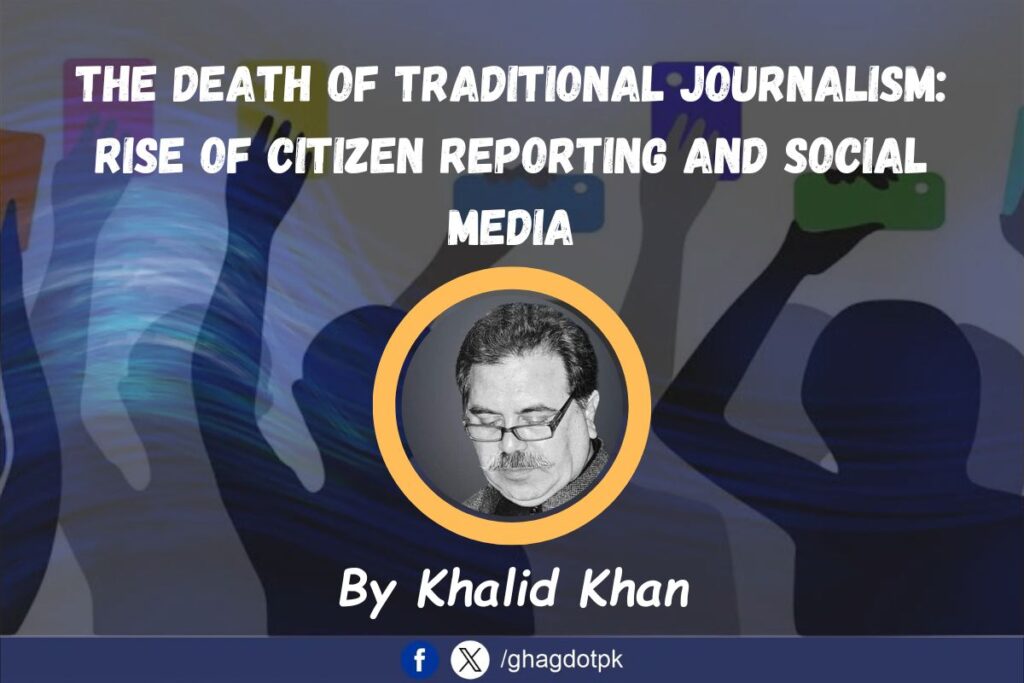By Khalid Khan
In an era where technology shapes every aspect of human interaction, journalism, too, is undergoing a tectonic shift. Elon Musk’s assertion that “journalism is dead” and the future belongs to platforms like X (formerly Twitter) and other social media highlights a growing trend. He describes a world where every citizen becomes a journalist, capturing and posting real-time news directly from their perspective. This transformation raises important questions about the state of traditional journalism, the rise of citizen reporting, and the implications for the media landscape.
The Decline of Traditional Journalism
Journalism, once heralded as the “fourth pillar of democracy,” is increasingly losing public trust and relevance. According to the 2023 Edelman Trust Barometer, trust in traditional media has plummeted to just 37% globally. In countries like the United States, this number is even lower, at 26%, reflecting a growing disillusionment with mainstream media’s perceived bias, corporatization, and sensationalism.
Television anchors and print journalists, often bound by corporate interests, face criticism for prioritizing profit over authentic storytelling. Large media houses rely heavily on advertising revenue, making them vulnerable to the influence of powerful corporations and political entities. A Pew Research Center study from 2023 revealed that 72% of Americans believe that media outlets prioritize their financial interests over ethical reporting.
The financial model of traditional journalism is also under strain. Print circulation has dropped by 45% globally over the last decade, and advertising revenues for newspapers fell by 57% between 2008 and 2023, according to a report by Statista. The same trend is evident in television news viewership, which has declined sharply as younger audiences move to digital platforms.
In Pakistan, the situation is even direr. Press freedom has been under siege, with journalists facing intimidation, censorship, and attacks from state and non-state actors. According to Reporters Without Borders, Pakistan ranks 150 out of 180 countries in the 2023 World Press Freedom Index. Traditional outlets are frequently pressured into self-censorship, reducing the public’s trust in their ability to report freely. The rise of social media has filled this vacuum, enabling citizens to bypass traditional media channels and bring critical issues—such as corruption, governance failures, and human rights abuses—to the forefront.
The Rise of Citizen Journalism
In this vacuum, citizen journalism has emerged as a formidable force. Armed with smartphones and social media accounts, ordinary individuals now act as frontline reporters, capturing events in real-time. Platforms like X, Facebook, and Instagram are flooded with videos, images, and posts that often precede coverage by traditional outlets. A Reuters Institute survey found that 51% of people globally now get their news from social media, with platforms like X leading in breaking news dissemination.
Citizen journalists are uniquely positioned to deliver authentic, unfiltered accounts of events. They bypass the corporate filters and editorial biases that plague traditional media. For example, during the Arab Spring, social media played a pivotal role in documenting protests and state violence, providing the world with firsthand accounts that mainstream outlets often failed to report. Similarly, in Pakistan, citizen journalists have exposed stories that traditional outlets either ignored or downplayed. Viral social media posts have highlighted issues ranging from police brutality to political corruption, compelling mainstream media to follow suit.
Strengths and Weaknesses of Citizen Journalism
While citizen journalism democratizes information, it also comes with challenges. Authenticity and fact-checking are often major concerns. A study by MIT found that false information spreads six times faster on social media than verified news. Citizen reporters, untrained in journalistic ethics, can unintentionally or deliberately spread misinformation.
Despite these challenges, the immediacy and reach of citizen reporting have made it indispensable. During natural disasters, protests, or wars, citizen journalists are often the first to provide visuals and updates. In Pakistan, where rural and remote areas are often ignored by urban-centric media, citizen journalists play a crucial role in reporting local issues such as flooding, land disputes, and tribal conflicts.
Social Media’s Role in Journalism’s Transformation
Elon Musk’s platform X exemplifies this shift. Under his leadership, X has introduced features like community notes and subscription-based content from independent creators, empowering individuals to monetize their reporting. Platforms like TikTok and Instagram, once primarily for entertainment, now serve as news hubs for younger demographics. A Reuters Institute Report found that 40% of people aged 18-24 prefer getting news from TikTok over traditional sources.
In Pakistan, where smartphone penetration has reached over 50%, social media platforms are a dominant source of information for the youth. According to Hootsuite’s 2023 Digital Report, 70% of internet users in Pakistan rely on social media for news, with WhatsApp and Facebook being the most popular platforms. This shift has disrupted traditional media, forcing even large news organizations to adopt digital-first strategies to stay relevant.
The Future of Journalism
The future is a hybrid of traditional and digital paradigms. As traditional journalism continues to decline, major outlets are pivoting toward digital-first strategies. Paywalls, subscription models, and partnerships with social media influencers are some ways traditional media is adapting. Meanwhile, the rise of AI in news creation and distribution will further revolutionize the field.
However, the responsibility of credible reporting now falls on every individual with internet access. As Musk aptly stated, “Every citizen is now a journalist.” This decentralization of news brings both opportunities and challenges, emphasizing the need for media literacy and ethical guidelines for social media users.
Conclusion
Traditional journalism, once the cornerstone of informed democracies, is facing an existential crisis. While social media and citizen reporting offer an exciting alternative, they also come with risks of misinformation and lack of accountability. The transition from centralized to decentralized journalism is inevitable, but it requires a collective effort to maintain the integrity of information in this new era.
In Pakistan, where press freedom faces significant hurdles, citizen journalism is becoming a lifeline for truth. Musk’s vision of journalism may not just be a prediction but a reality for societies grappling with censorship and systemic biases. This transformation may redefine how stories are told, who tells them, and how the world listens.






